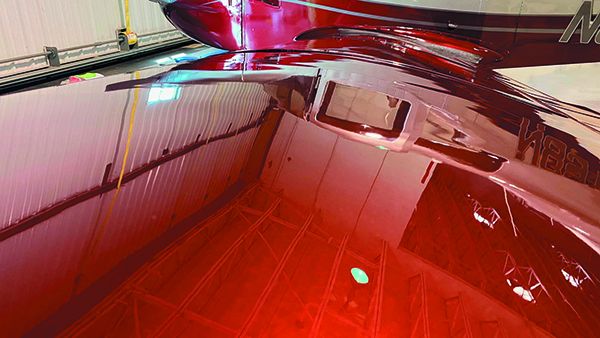Wouldn’t it be great if we could clearcoat our airplane with a high-gloss finish and simply keep it shining by washing it several times a year? Enter ceramic coatings, which appear to be a step in that direction, but at a price premium and not without big effort.
For this article, I brought my Grumman—that sports a new $20,000 clearcoat paint job—to a professional aircraft detailer for a ceramic finish. Herewith are the short-term results, tips and potential pitfalls, with some advice for attempting DIY ceramic coatings.
CERAMIC COATINGS 101
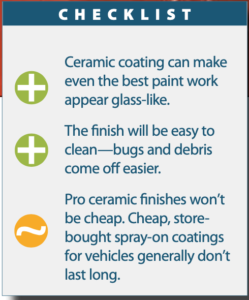
Going back over a century, George Simons created a car cleaner from carnauba wax, and ultimately the term “Simonize” was born. The downside of natural waxes is their short protection lifespan. Are you able to remember the bygone era when cars had to be waxed every couple of months?
Leap ahead to 1969, when Dupont developed the first polymer sealant. Based on a report in Aviation Consumer 20 years ago, I began using Wing Waxers, a Teflon sealant. A clear improvement over carnauba wax, the Teflon would last almost a year between applications.
Leap ahead again to the new millennium, where ceramic coatings are becoming the next surge based on new technologies. It’s simple—ceramic forms a powerful chemical bond with the paint, and the typical claims are that the finish lasts three to five years when professionally applied. Some claim it might last nearly 10 years, but I’m skeptical of that.
Still, while more prevalent in the automotive detailing industry, ceramics are finally getting a foothold in the aviation market, starting several years ago at the corporate jet level. The tech is new enough that even the internet is devoid of any good information relating to aviation-specific products or application. So our decision making as aircraft owners is left mostly to the marketing hype in the automotive arena.
The main component of ceramics is silicon dioxide (SiO2), which is also a major component in glass. Sam Stearns, of Immaculate Flight, a nationwide aircraft detailer, pointed out the benefits that go beyond cosmetics.
“Ceramic coatings semi-permanently adhere to exterior surfaces and offer the best available resistance against UV ray damage, corrosion, oxidation, heat, chemical attack and other environmental impacts,” he told me. Moreover, ceramic coatings cannot be washed away or chemically stripped. The only way to remove them is by abrasion or sanding. A properly cured ceramic coating generates an extremely hard surface that is glossy, uniform, smooth and exceptionally durable. As an aircraft detailer, ceramic coatings make his job easier. “A prominent added benefit is that coatings are hydrophobic (water-repellent), which makes it harder for contaminants to adhere to the surface. This can result in easier, less time-consuming cleanings,” he noted.
Hydrophobia could also prove to be a short-term benefit if you inadvertently stumble into icing conditions because it may delay the accumulation of airframe ice and give you a few minutes to get out of it. But, this has not been tested and of course it isn’t approved, but it is something to ponder. Last, ceramics also add a candy-like gloss, making the already stellar paint work on my Grumman even more stunning.
PROFESSIONAL JOBS
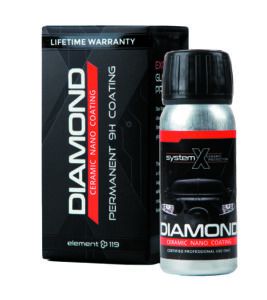
We looked at both professional applications and the do-it-yourself method; each has its pros and cons. For this article I’ll focus primarily on a professional application, and in a follow-up article I’ll check back in for an update on how the finish is holding up, and will have more long-term results on DIY projects.
For certain, it’s easy to suggest pro applications. I found that professionals have access to ceramic systems not typically available to the consumer, and it’s those products that make the three- to five-year longevity claims. And because the formulation is made to last a long time (containing a higher concentration of SiO2), there is a slim margin of error in application.
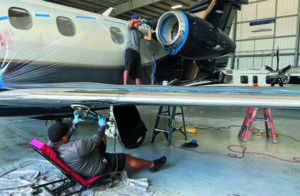
Only a few aviation-specific ceramics exist on the market today, such as System X by Element 119, advertised as being tested and approved by Boeing. System X comes in three grades: Renegade, Diamond and Extreme. The Grumman Tiger was coated with Extreme on the sun-facing surfaces and with Renegade on the ground-facing ones. CeramicPro is another pro-only product.
As an added benefit, the professional detailer typically has a host of tools and products at their disposal, which are designed to meet every restoration need. Consider that the condition of the paint—from new to badly oxidized—requires different treatments to bring out the best glossy shine from a ceramic coating.
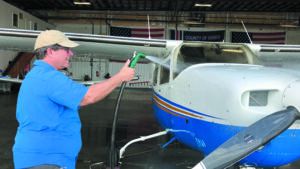
And as you would expect, professional application is more costly. Ceramic materials are expensive. The amount used to protect the Tiger cost the detailer around $600 wholesale. Also, because ceramics haven’t really trickled down to the light aircraft market in volume, it’s generally high-end detailers catering mostly to the jet crowd, with the average light single costing between $1200 and $3000, depending on paint condition at the outset. However, small shops churning out quality work (NuAero is one that comes to mind) can be found with some due diligence.
Face it, many aircraft owners, myself included, take the DIY route to save money when we can. Flight Shield’s Sapphire V1 is the only aviation-specific ceramic I could find that is for sale directly to the consumer. Otherwise, DIY’ers are left with a host of automotive products. Consumer-grade ceramics are specially formulated for easier application, using reduced SiO2 content, which slows the flash off, allowing you more open time to work the ceramic before it’s cured to an impervious film. But you can botch the job with ugly results.
Open time is only a few minutes and, much like Krazy Glue, once it cures, you’re done. Improper application can leave streaks, high spots, hazing and horrible reflections. So, you’d better know what you’re doing, because once this thing sets, it cements over your paint for the next year or more.
Another major drawback to DIY ceramic jobs is that the protection won’t last nearly as long. As far as I can tell, one year seems to be the real benchmark in the automotive world, based on the many consumer product reviews I read.
THE PROCESS
It’s easy to overthink the ceramic application process, and while critical, it roughly follows the same process as applying any wax or sealant.
• Thoroughly wash the aircraft and degrease the underbelly.
• Compound/polish the paint to remove any oxidation or defects. The paint needs to be in as near-perfect condition as possible because ceramics are a clear coat, and as such, what you see before application is what you get when complete.
• Use an IPA alcohol/water wipe to remove any compound residue.
• Apply the ceramic in 2-by-2-foot increments. Wipe on a thin layer, and wipe off excess in a straight line. Buff it dry with a circular motion and let it dry for two hours before touching the surface.
• Allow the finish to cure for 24 hours minimum without exposing the ceramic coating to direct sunlight or moisture. Plan on storing the aircraft in a dry, cool hangar during the entire process.
RESULTS
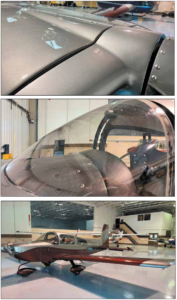
Not sure what to expect of ceramic coating a newly painted airplane, I was beyond words when I saw my finished Grumman. After ceramic coating, the plane looked better than the day it left the paint shop five months prior—which I didn’t think was possible. The $1265 invoice (when divided by five years) works out to only $253 a year. Factor in no grunt cleaning work for five years and I call that money we’ll spent to protect a premium paint job. I’m not alone—a corporate flight department head had this to say about ceramic finishing work accomplished by NuAero Detailing.
“I have been in the corporate aircraft business for over 30 years, and I have never been more impressed with a detailing company than I am with NuAero Detailing. They take care of our two Hawkers and a Challenger 350 like it was their own,” he said. There’s definitely the advantage of easy upkeep.
“We had all three aircraft ceramic coated roughly two years ago and they have held up great and look brand new. We operate out of an airport that’s along a river and the bugs are bad, especially at night. All we have to do is wipe the aircraft with soap and water and the bugs come right off,” he told me.

It’s important to understand that not all ceramics are created equal. You’ll see people using products that they picked up on Amazon, Walmart or the local auto parts retailer at a cheaper price. The fact is that these products might appear to give similar results, but will wear off quickly and won’t actually provide the protective layer that a high-quality ceramic product will. In terms of preparing the paint, many DIY’ers might not realize how porous paint actually is. Contaminants become lodged in the pores, and simply washing the paint is not sufficient enough to remove everything. And without proper paint preparation, you risk sealing contaminants to the paint, as we’ll as compromising the integrity of the sealant should that contaminant dislodge.
At Immaculate Flight, we use SystemX ceramic, a product that has been tested and proven to be safe and effective on aircraft paint. It is extremely important to use products that are approved for use on your aircraft. Using unapproved products can potentially void warranties on paint, or with aircraft manufacturers.
The System X ceramic coating is SiO2 (silicon dioxide) based. SiO2 coatings consist of nanoparticles of silicon dioxide suspended in a resin. The term “silica” or “glass” is often used because the cured coating is literally a layer of silicon dioxide molecules that is a couple of microns thick (a micron is one-millionth of a meter). Silica (SiO2) occurs commonly in nature as sandstone, silica sand or quartzite. It is the starting material for the production of silicate glasses and ceramics.
Ceramic coatings semi-permanently adhere to exterior surfaces and offer the best available resistance against ultraviolet (UV) ray damage, corrosion, oxidation, heat, chemical attacks and other environmental impacts. Ceramic coatings cannot be washed away or chemically stripped. The only way to remove them is by abrasion or sanding. A properly cured ceramic coating generates a very hard surface that is glossy, uniform, smooth and highly durable. A prominent added benefit is that coatings are hydrophobic (water-repellent), and make it harder for contaminants to adhere to the surface. This can result in cleanings being easier and less time-consuming.
It is also important to note that the environment has a direct impact on cure time, which is why it is extremely important to have a qualified applicator perform this service. The SiO2 is suspended in a carrier fluid that evaporates once applied, leaving only the glass. This fluid is self leveling, but it doesn’t happen instantaneously. In temperatures that are too cold, the fluid will not evaporate fast enough. In extreme heat, it may evaporate before it levels out, and in high-humidity environments, where the air is already saturated with water, it will not allow the fluid to evaporate. It’s similar to why sweat beads up on our skin on humid days. In arid environments, our sweat would evaporate much faster. The perfect environment for applying ceramic is on warm dry days, in a hangar with plenty of light.
The results really speak for themselves. We regularly get feedback from customers who say that their paint has never looked better, even when they’re fresh out of the paint shop.
—Immaculate Flight
THE TAKEAWAY, SO FAR
Based on the difficulty of the application and the longevity of professional products (and despite the increased cost), I think that ceramics are best left to the professionals. For one thing, aircraft detailing pros are accountable to present you with a defect-free finish and should offer a warranty on their work. Not all professionals are created equal.
I am aware of failed pro ceramic jobs that lasted less than a year when improperly applied. Like any other work, do your due diligence and get a few references beforehand. Also understand that shops that work with high-end bizjets may not want to bother with small GA machines. The money just isn’t there given the effort that’s required.
When determining the value relationship of a professional versus DIY job, a professionally applied ceramic coating could be the best value to those with a paint condition of 7 or better. Face it, at some point, paint is beyond rejuvenation. The phrase “Lipstick on a pig” certainly applies to ceramic finishes.
There will always be those who chose to dabble in the DIY arena simply for the sheer joy of doing the work themselves. There is nothing wrong with that, if you understand the risks before pulling the trigger. Elbow grease will mean significant savings, and plan on doing the process annually—at least. You could always practice on your vehicle.

At the right is a list of select pro detailers offering ceramic finishes.

